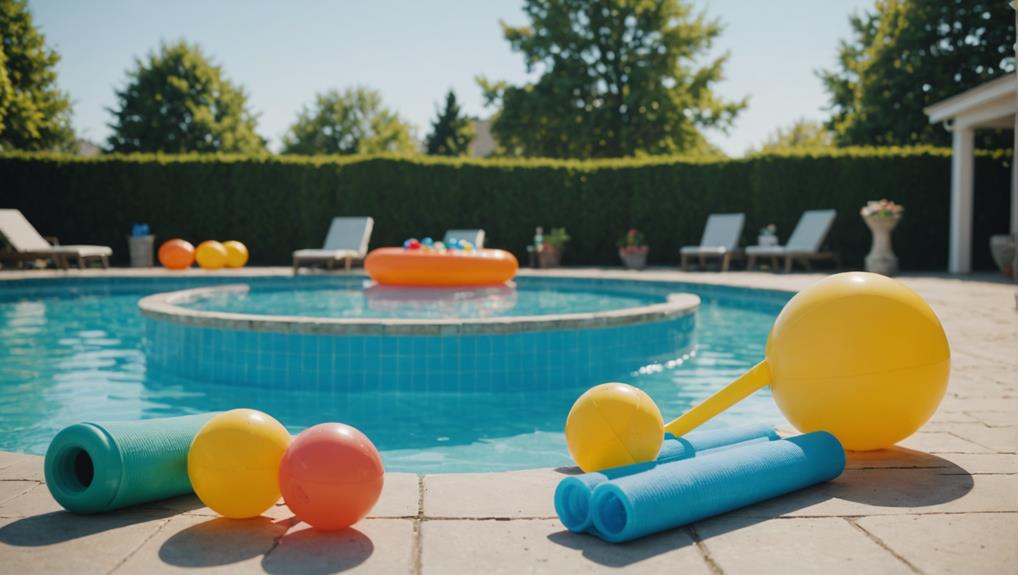You need to understand that proper pool filter care involves regular inspection, monitoring, and maintenance to prevent clogs, damage, and costly repairs, and to guarantee your pool water remains clean and clear. Start by familiarizing yourself with your filter type, whether it’s sand, cartridge, or diatomaceous earth. Inspect the filter tank and elements monthly, and monitor the pressure gauge to know when it’s time to clean or backwash. Regular maintenance is key, as neglecting your filter can lead to serious problems. By following these basics, you’ll be well on your way to peak filter performance – and there’s more to learn to guarantee your pool stays in top shape.
Key Takeaways
- Inspect the filter tank, cartridges, and grids monthly for cracks, corrosion, blockages, dirt, and debris to ensure optimal performance.
- Monitor the pressure gauge regularly, as an increase of 8-10 psi above the standard level indicates the need for filter cleaning.
- Regular backwashing and cleaning maintain the filter’s performance, extend its lifespan, and prevent clogs and damage.
- Familiarize yourself with the filter’s manufacturer instructions for specific maintenance, cleaning, and storage procedures to avoid damage and ensure longevity.
- Develop a routine for maintaining the pool filter, including regular cleaning, backwashing, and inspections, to guarantee clean and clear water.
Understanding Filter Types
When it comes to maintaining your pool’s filtration system, it’s vital to understand the type of filter you’re working with, as each of the three main types – sand, cartridge, and diatomaceous earth (DE) – has its own unique characteristics and maintenance requirements.
Sand filters, for instance, use a bed of specialized sand to trap dirt and debris, releasing filtered water back into the pool.
Cartridge filters, on the other hand, consist of a plastic tank containing cartridges with pleated polyester filter media, making them ideal for small pools and spas.
DE filters, considered the most effective filtering agent, use grids coated in white DE powder to clean the water, capable of filtering particles as small as 3-5 microns.
Understanding your filter type is essential for effective care, as each requires specific cleaning and maintenance procedures.
By recognizing the type of filter you have, you’ll be able to tailor your maintenance routine to its unique needs, ensuring peak filtration and a healthy, safe swimming environment.
Regular Filter Inspection
By grasping the unique characteristics of your filter type, you’re now ready to implement a regular filter inspection routine to guarantee it continues running at peak performance. This vital step safeguards your filter remains in top condition, preventing system failure and costly repairs. During inspections, look for signs of wear and damage, such as cracks, corrosion, or blockages in the filter tank, pipes, and valves.
| Inspection Area | What to Check | Frequency |
|---|---|---|
| Filter Tank | Cracks, corrosion, blockages | Monthly |
| Filter Cartridge/Grids | Dirt, debris, mineral buildup | Monthly |
| O-Rings and Gaskets | Signs of wear or damage | Monthly |
Regular inspections can help detect potential issues before they cause system downtime, saving you time and money on repairs and replacements. Be sure to clean or replace the filter cartridge or grids as needed, and perform a backwash cycle to remove any debris. Remember to consult your filter’s manufacturer instructions for specific inspection and maintenance recommendations. By staying on top of regular filter inspections, you’ll enjoy a cleaner, safer, and more efficient pool experience.
Monitoring Pressure Gauges
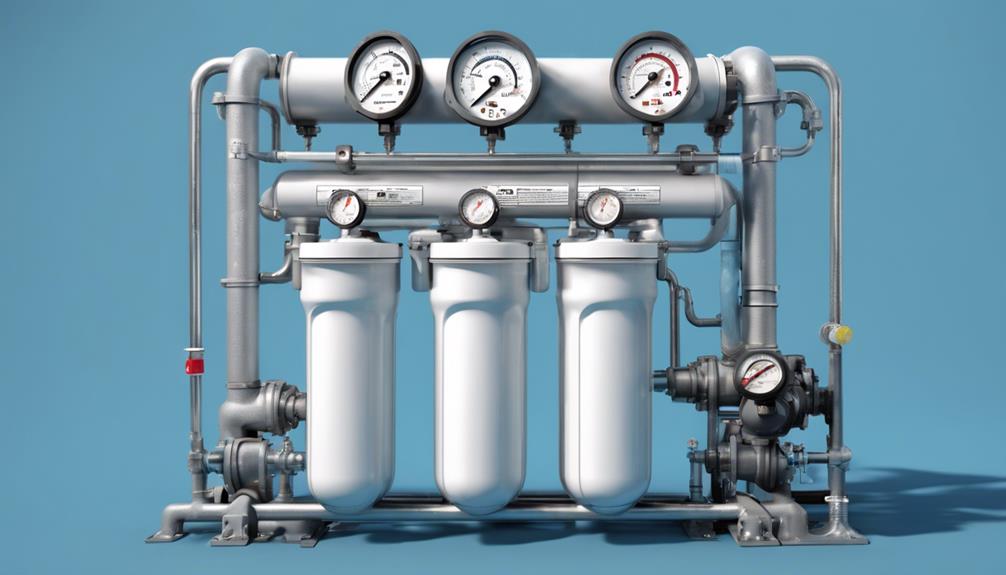
You’ll want to keep a close eye on your filter’s pressure gauge, as it serves as a vital indicator of the filter’s condition and performance. This gauge is your go-to source for determining when your filter needs a good cleaning or even replacement.
A pressure gauge reading 8-10 psi above the standard level indicates that the filter needs to be cleaned, and neglecting these warnings can lead to filter damage.
Pressure gauges help determine if the filter is operating within its ideal range, ensuring clean and clear water for your pool.
Regular monitoring can help prevent clogs and reduce strain on the filter, extending its lifespan and reducing the need for frequent backwash cycles.
Backwashing and Cleaning
Proper backwashing and cleaning of your pool filter are crucial maintenance tasks that remove dirt, debris, and other contaminants, restoring the filter’s efficiency and preventing damage.
To backwash the filter, shut off the pump and switch the valve to the ‘backwash’ position. Connect the backwash hose to the waste port and verify it’s securely attached. Turn on the pump and allow it to run for 2-3 minutes, or until the water runs clear. This process reverses the flow of water, removing dirt and debris from the filter.
After backwashing, clean your pool filter using a filter cleaning solution. This will help break down any remaining dirt and grime. Remove the filter tank and take out the filter elements. Soak them in the cleaning solution for the recommended time, then rinse thoroughly.
Reassemble the filter tank and replace the filter elements. Regular backwashing and cleaning will maintain your filter’s performance and extend its lifespan. Remember to always refer to your filter manufacturer’s instructions for specific backwashing and cleaning procedures.
Preventing Filter Damage
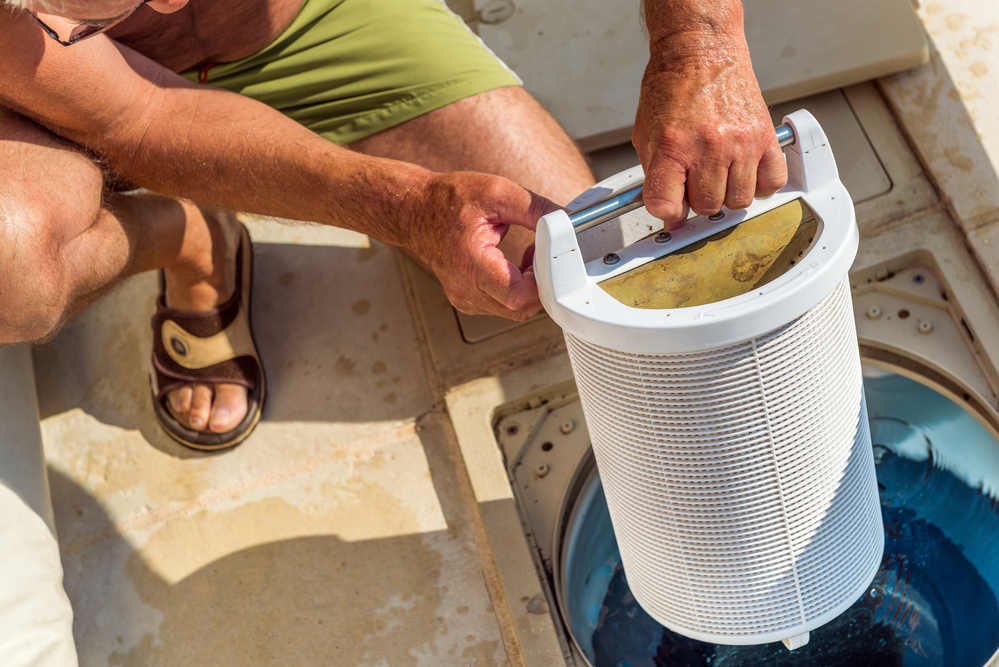
Regular maintenance is essential to prevent filter damage, as neglecting routine tasks can lead to costly repairs, decreased performance, and poor pool water quality.
To avoid these issues, it’s vital to stay on top of filter cleaning and maintenance.
Failure to clean your filter regularly can cause it to become clogged, leading to increased pressure and potentially damaging the filter or other pool equipment, such as the pump or air relief valve.
Neglecting to backwash your sand filter can cause the sand to become compacted, reducing its effectiveness and potentially leading to cloudy pool water.
Using the wrong cleaning products or methods can damage the filter media or other components, reducing its lifespan and effectiveness, especially for delicate pool filter cartridges.
Failing to replace worn or damaged O-rings or gaskets can cause leaks and reduce the filter’s performance, leading to poor pool water quality and potentially affecting the entire filter manifold.
Deep Cleaning Essentials
To tackle deep cleaning, it’s crucial to understand the key steps involved in disassembling your filter and planning your maintenance schedule.
You’ll want to familiarize yourself with filter disassembly tips to guarantee you’re properly cleaning each component, and set reminders for annual maintenance to keep your filter running efficiently.
Filter Disassembly Tips
As you prepare to plunge into the deep cleaning process, disassemble your pool filter with caution, following the manufacturer’s instructions to avoid damaging the filter or its components.
Before you start, turn off the pump and depressurize the filter tank to prevent injury or damage from pressurized water or air.
Remove all clamps, latches, or other securing mechanisms to access the internal components of the filter, taking care not to strip or damage any threads or fittings.
Use a soft-bristled brush or gentle cleaning tool to remove dirt, debris, and old filter media from the filter’s internal surfaces, avoiding the use of harsh chemicals or abrasive materials that can damage the filter.
Inspect each component carefully during disassembly, looking for signs of wear, damage, or corrosion, and replace any parts that are no longer functional or show excessive wear.
Take note of the filter manifold, filter pressure range, and filter grids as you disassemble, as these components require special attention during cleaning and reassembly.
Annual Maintenance Reminders
To guarantee your pool filter operates at peak performance and maintains crystal-clear water, you should schedule annual deep cleaning sessions, tailored to your filter type, to prevent clogs, reduce pressure on the pump, and optimize energy consumption.
For sand filters, this means backwashing and chemically cleaning the filter to remove dirt and debris that can affect water quality and filter performance.
Cartridge filters require soaking in a filter cleaning solution every 6-12 months to remove built-up dirt and debris, while DE filters need disassembly, grid cleaning, and recharging with new DE powder every 2-3 years.
Regular maintenance can keep your filter system running smoothly and efficiently.
Failure to perform annual deep cleaning can lead to reduced filter performance, increased energy consumption, and potentially even filter damage or failure.
Professional Maintenance Tips
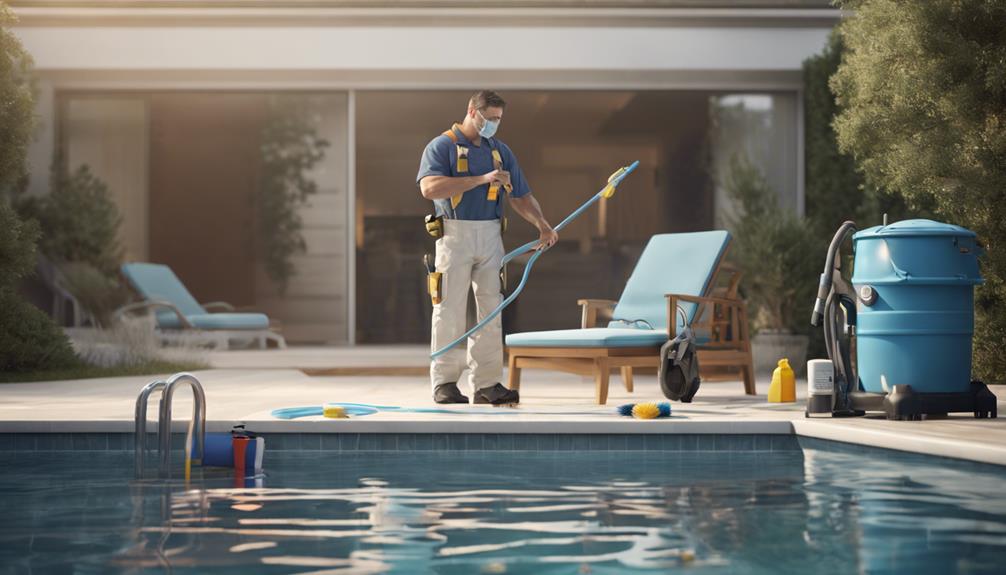
You can guarantee your pool filter operates at peak efficiency by implementing a routine maintenance schedule that includes regular cleaning and inspection of the filter elements. This will verify your pool water remains crystal clear and safe for swimmers.
Regularly backwash your filter: This removes dirt and debris that can clog your filter cartridge, reducing its effectiveness. Be sure to follow the manufacturer’s instructions for backwashing frequency and duration.
Check for air in the system: Air pockets can reduce your pump’s performance and cause damage to your filter system. Check your pump and filter regularly for signs of air leakage.
Use clean sand: Make sure your filter’s sand is clean and free of debris. Dirty sand can reduce your filter’s effectiveness and lead to premature wear.
Monitor your DE levels: If you have a DE filter, confirm you’re maintaining the correct DE levels. Too little DE can lead to poor filtration, while too much can cause clogs and damage to your filter.
Winter Storage Precautions
When storing your pool filter for the winter, take precautions to prevent freezing and damage by following a few critical steps to guarantee your filter remains in top condition until the next swimming season.
First, drain the filter and clean it thoroughly according to the manufacturer’s instructions to remove dirt and debris that can cause damage during the winter months.
Apply a filter cleaner or lubricant to the O-rings and gaskets to keep them from drying out and cracking during storage.
Next, store the filter in a dry, protected area, such as a garage or shed, to prevent water from collecting in the tank and causing corrosion or damage.
Consider storing the filter in a vertical position to further prevent water accumulation.
Finally, consider using a filter cover or wrap to protect the filter from the elements and prevent damage from weathering during the winter storage period.
Filter Maintenance Schedules
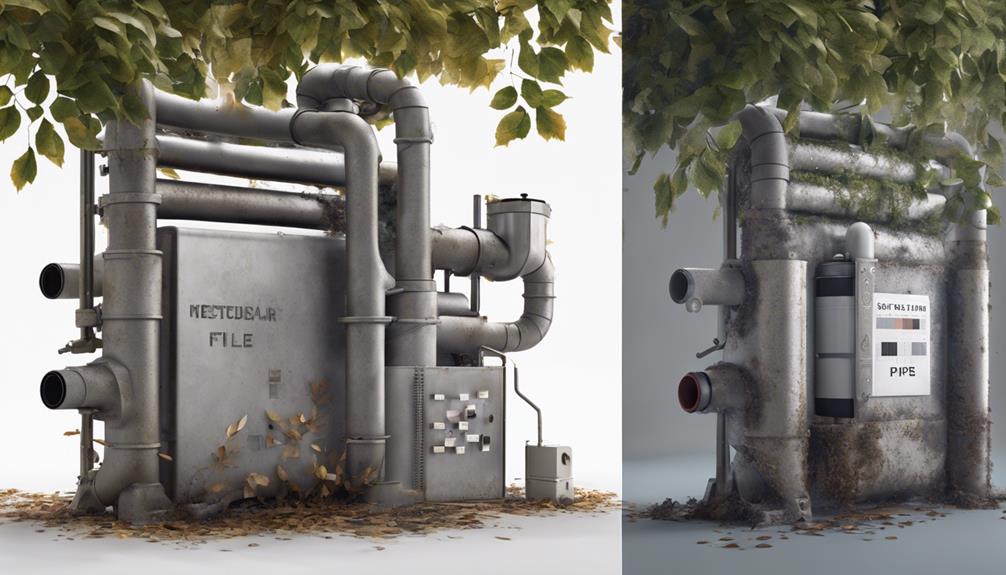
Regularly adhering to a filter maintenance schedule is crucial to ensuring peak pool performance and longevity of the filtration system.
As a pool owner, you need to understand that different filter types require varying levels of maintenance.
Sand filters typically require backwashing every 3-5 years, while cartridge filters need to be cleaned every 3-6 months, and DE filters need to be backwashed and cleaned every 1-3 months.
The ideal cleaning schedule for a pool filter depends on the type of filter, pool usage, and water quality, with more frequent cleaning needed for high-traffic pools or those with poor water quality.
A pressure gauge reading 10 PSI higher than normal indicates the need for immediate cleaning of the filter, regardless of the scheduled maintenance date.
Failure to adhere to a regular cleaning schedule can lead to clogged filters, poor water quality, and even damage to the pool equipment or surrounding infrastructure.
Filter Care Best Practices
As you implement your filter maintenance schedule, it’s vital to follow best practices to guarantee your filter operates efficiently and effectively.
You’ll want to focus on regular cleaning, backwashing, and using the right techniques to avoid damaging your filter or other pool equipment.
Filter Maintenance Tips
You’ll need to develop a routine for maintaining your pool filter to prevent clogs, reduce pressure, and guarantee clean and clear water. This routine should include regular monitoring of the pressure gauge, as an increase of 8-10 psi indicates the need for cleaning. Neglecting pressure gauge warnings can lead to filter damage, so it’s vital to stay on top of it.
Regular backwashing helps remove dirt and debris from your filter, and should be done according to the manufacturer’s recommendations.
Proper cleaning methods vary depending on the type of filter you have. Sand filters require backwashing, cartridge filters need to be hosed down and cleaned with a filter cleaner, and DE filters require periodic backwashing and refilling with DE powder.
Remove any visible debris from the filter to prevent clogs and dirty water.
Regular maintenance of your pool filter can help reduce the need for costly repairs and replacements, saving you money in the long run.
Regular Cleaning Schedule
To guarantee your pool filter operates efficiently and effectively, this is vital to establish a regular cleaning schedule, which should be based on the manufacturer’s instructions, pool usage, and pressure gauge readings.
You should clean your pool filter at least once a month, or when the pressure gauge reading increases by 10 psi, whichever comes first. This will guarantee clean and safe pool water.
For cartridge filters, you’ll need to clean them every 1-3 months, depending on the manufacturer’s instructions and pool usage.
Sand filters require backwashing every 3-6 months and chemical cleaning at least once a year.
DE filters need cleaning every 1-3 months, and their grids should be replaced every 2-3 years.
By following a regular cleaning schedule, you’ll be able to reduce energy consumption, prevent pool downtime, and extend the lifespan of your filter and other pool equipment.
A dirty filter can lead to poor pool water quality and increased maintenance costs. Stay on top of your filter’s maintenance to keep your pool clean and safe.
Backwashing Essentials
By incorporating backwashing into your regular maintenance routine, you’ll guarantee your filter operates at peak performance and prevent dirt and debris from accumulating. Backwashing is a vital step in maintaining a clean and efficient pool filter. It reverses the flow of water through the filter, removing dirt and debris that’s built up in the filter cartridge.
To backwash your filter, follow these steps:
Make sure to close the pumps strainer lid and set the multiport valve to the ‘Backwash’ position before starting the process.
Allow the backwashing process to run for 2-3 minutes to confirm all dirt and debris are removed.
After backwashing, switch the multiport valve to the ‘Rinse’ position to remove any remaining dirt and debris.
Finally, set the valve to the ‘Filter’ position and open the pumps strainer lid to resume normal filtration.
Remember to backwash your filter regularly to prevent it from getting dirty and clogged. You should also consider using a pressure washer to clean the relief valve and drain plug during the Backwash and Drain process. By following these steps, you’ll keep your pool filter running smoothly and efficiently.
Frequently Asked Questions
How to Take Care of a Pool Filter?
You take care of a pool filter by regularly inspecting and replacing it, ensuring proper water circulation, and optimizing filter efficiency, pool sanitation, and sizing, while selecting the right filter type and location, protecting it from debris, and testing its performance.
Should You Leave Your Pool Filter on All the Time?
You shouldn’t leave your pool filter on all the time, as continuous operation reduces filter efficiency, increases energy consumption, and decreases filter longevity, compromising water circulation, pool safety, and overall performance, while also generating more equipment noise and clogging, with minimal power savings.
How Often Does a Pool Filter Need to Be Cleaned?
You’ll need to clean your pool filter regularly to maintain filter efficiency, as neglecting clean frequency can lead to filter clogging, decreased lifespan, and increased pressure gauge readings, requiring backwash mode, grid cleaning, and even filter replacement.
What Maintenance Does a Pool Pump Require?
You’re responsible for ensuring your pool pump runs smoothly, so you’ll need to perform regular maintenance tasks, including motor maintenance, electrical checks, oil changes, bearing lubrication, impeller cleaning, and valve inspection to optimize pump efficiency, reduce noise, and prevent corrosion.
Conclusion
You’ve made it to the final lap of pool filter care!
By now, you’re equipped with the knowledge to keep your filter running smoothly and efficiently.
Remember, a well-maintained filter is vital for your pool’s health and your family’s safety.
Did you know that a dirty filter can increase your energy bills by up to 20%?
Don’t let that happen! Stay on top of your filter maintenance and enjoy a sparkling clean pool all season long.

I’m Max, the founder and chief pool enthusiast behind Pool Pro Tips. As a passionate pool owner and cleaning expert, I created this website to share my knowledge and experience with you, helping you to keep your pool sparkling clean and safe for years to come.

